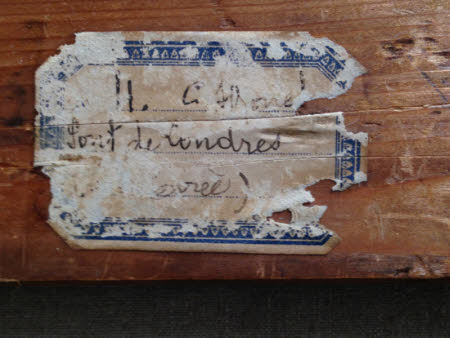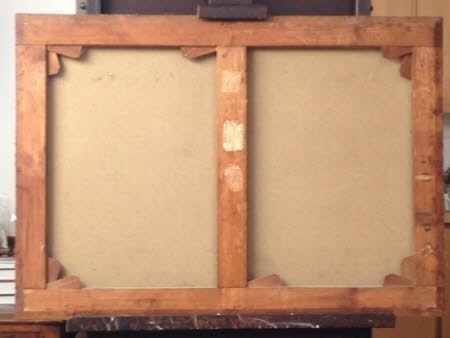Pont de Londres (Charing Cross Bridge, London)
Claude Monet (Paris 1840 - Giverny 1926)
Category
Art / Oil paintings
Date
1902 (signed and dated)
Materials
Oil on canvas
Measurements
641 x 902 mm
Place of origin
London
Order this imageCollection
Chartwell, Kent
NT 1102455
Caption
In 1949, Sir Winston Churchill (1874–1965) received a gift from his friend and literary agent Emery Reves (1904–81), which he described as ‘a very small token of my gratitude for your friendship’. The gift was highly appropriate as Reves knew that Churchill greatly admired the work of the French Impressionist artist Claude Monet (1840–1926). Monet painted this work on his last visit to London, and it may be the one described in his diary of February 1900, which documents that there was ‘an extraordinary fog, completely yellow; I think I did not too bad an impression of it; it’s always beautiful.’ Appropriately for this gift to Churchill, it presents a view over the River Thames towards Westminster and was painted from Monet’s rooms at the Savoy Hotel, one of many different versions he painted. At this date, Churchill was the leader of the Opposition, so Reves concluded his letter with a wish that ‘the fog that shrouds Westminster’ would lift. The painting remained a treasured possession at Churchill’s principal home of Chartwell House in Kent.
Summary
Oil painting on canvas, Pont de Londres (Charing Cross Bridge, London) by Claude Monet (Paris 1840 - Giverny 1926), signed and dated 1902.
Full description
Claude Monet (1840–1926) first visited London between 1870 and 1871 but it was not until he made three extended stays, in 1899, 1900 and 1901, that he fulfilled his long-held desire to ‘try to paint some effects of fog on the Thames' (Wildenstein 1979). For weeks and months at a time, he took up residence in the Savoy Hotel on the Strand where, from his window, he could paint the view downstream past Waterloo Bridge, and upstream to Charing Cross Bridge and the Palace of Westminster. He worked on large numbers of works simultaneously, seeking to catch the transient effect of light and colour in London’s wet, polluted atmosphere at different times of day. ‘I so love London!’ he told the dealer René Gimpel (1881–1945), but ‘without the fog, London wouldn’t be a beautiful city. It’s the fog that gives it magnificent breadth. Those massive regular blocks become grandiose within that mysterious cloak’ (Gimpel 1966). This is one of the paintings that he worked on at the Savoy, perhaps working on it repeatedly on consecutive visits. It presents the westerly prospect with a train emitting a plume of smoke as it crosses Charing Cross Bridge. The bulk of Victoria Tower looms above Palace of Westminster in the background. The whole scene is drenched in saturated colour, the pervasive yellow of the fog punctuated by lilac accents where the sunlight hits steam, smoke and water. It is inscribed with the date 1902, which indicates when Monet completed, and most likely sold, the piece. Winston Churchill (1874–1965) was given this painting as a joint Christmas and 75th birthday present in 1949 by his friend and literary agent, the collector Emery Reves (1904–1981). Although the subject was clearly appropriate for Churchill’s long political career, it was their joint love of Monet which primarily inspired the gift. An accompanying letter from Reves to Churchill, written on 23 December 1949, is deposited in the Churchill Archives Centre in Cambridge, and is worth transcribing in full: Dear Mr. Churchill, This is a true story. Knowing that Monet is your favourite painter I have been searching for one of his good paintings for many months. I have seen several, but none of his great period. By far the best I could find in Paris was a canvas of 1902 which has the added attraction of representing Charing Cross Bridge and Westminster in the morning fog. It is purest Impressionism, nothing but light and colour without any design. Opinion on that period of Monet is divided. Clemenceau and many others thought that this period was the peak of Monet’s art, but most people believe that he produced his really great paintings between 1870 and 1880. Unfortunately I belong to the latter school of thought and, although this painting is reproduced in several books, I decided to wait until I found one I liked better. To my great surprise I discovered at the French Landscapes Exhibition at the Royal Academy the exact pendant of this paining, lent by a Paris collector. In the Academy the picture looks good, although it is much more sketchy and not so well painted as the one I found in France. I discussed this canvas with John Rothenstein of the Tate Gallery who was extremely eulogistic, even using the term “masterpiece”. I wanted to be sure and asked him: “would you hang it in the Tate Gallery?” to which he most emphatically answered that he would be more than happy to do so. Encouraged by the thought that if you do not like it you can always give it to the Tate, I arranged for the painting to be brought over this morning. Please accept it as a very small token of my gratitude for your friendship, which has been for so many years my greatest pride. That this comes between your 75th birthday and Christmas is not purely coincidental. My very best wishes for a happy 1950 during which I hope you will dissipate the fog that shrouds Westminster. Yours very sincerely Emery Reves
Provenance
Purchased from the artist by Bernheim Jeune, July 1923; purchased from them by the collector Henri-Edmond Cannone (1867-1961), Paris, January 1926 (described in Arsène Alexandre, La Collection Canonne, Paris, Bernheim-Jeune, 1930, pp. 31-2); sold by Jacques Cannone, 'Tableaux Modernes [...] appartenent de Mr J.C', Hotel Drouout, Paris, 5 June 1942, lot 15; purchased by Etienne Ader; purchased by Emery Reves (1904-1981) from an unknown seller, Paris, 1949; given by Reves to Winston Churchill, 1949 (French Customs label); accepted by the Treasury as a part of death duties and then placed on 50-year loan to the Trust from 1967; transferred to the National Trust by HM Treasury, 1984.
Credit line
Chartwell, The Churchill Collection (National Trust)
Marks and inscriptions
Signed and dated 1907
Makers and roles
Claude Monet (Paris 1840 - Giverny 1926), artist
Exhibition history
Sherlock Holmes, London Museum, 2014 - 2015
References
Catalogue of an exhibition of landscape in French art, 1550-1900: Royal Academy of Arts, 10 December 1949-5 March 1950, The Arts Council of Great Britain, London 1949, p. 66. no. 257 Gimpel 1966: René Gimpel, Diary of an Art Dealer, New York 1966, p. 129 Wildenstein 1979: Daniel Wildenstein, Claude Monet, Vie et Œuvre, Tome III, Lausanne et Paris 1979, p. 223, letter no. 797 Wildenstein 1985: Daniel Wildenstein, Claude Monet, biographie et catalogue raisonné, Lausanne & Paris 1985, pp. 164-5, 416, no. 1540, letters 2525, 2527; N.B. the provenance Wildenstein gives has been questioned Tucker 1995: Paul Hayes Tucker, Claude Monet: Life and Art, New Haven and London 1995 Wildenstein 1996: Daniel Wildenstein, Claude Monet, catalogue raisonné, Cologne 1996, p. 666, no. 1540; N.B. the provenance Wildenstein gives has been questioned Werner 2014: Alex Werner, Sherlock Holmes: The Man Who Never Lived and Will Never Die, exh.cat. Museum of London, 17 October 2014 - 12 April 2015, p. 141 Corbeau-Parsons 2017: Caroline Corbeau-Parsons (ed.), Impressionists in London: French Artists in Exile, exh.cat. Tate Britain, London, Petit Palais, Paris, 2017-18 Serres 2024: Karen Serres, with contributions from Frances Fowle and Jennifer A. Thompson, Monet and London: Views of the Thames, exh.cat., The Courtauld Gallery, London, 2024-5, no. 5, pp. 112-5.






